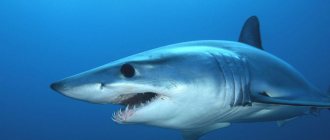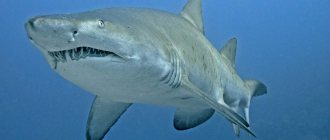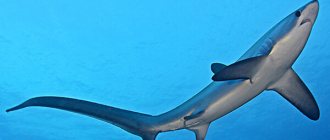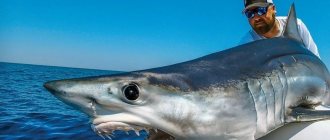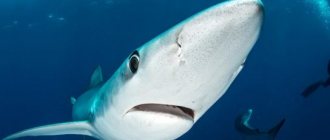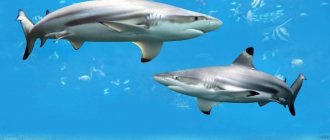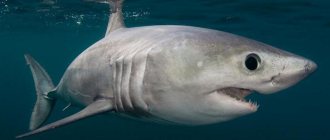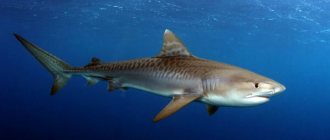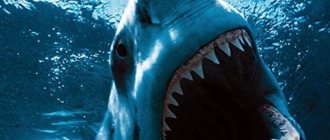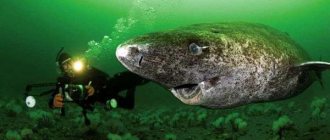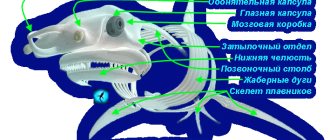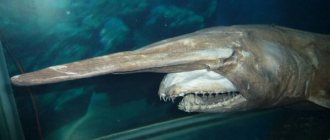Perhaps the mako can serve as a kind of standard for a predatory shark. This fearless and dexterous inhabitant of the open sea often enters the coastal zone, which, combined with its aggressive character and great gluttony, makes it very dangerous for humans.
The streamlined, spindle-shaped body of the lightning shark, reminiscent of a torpedo, allows it to reach a speed of at least 40 km/h (according to various sources, up to 60 or 90 km/h).
Mako test drive - 80 km/h:
Origin of the species and description
Photo: Mako Shark
Mako (Isurus) is one of the genus of the herring family, and the closest relatives of the famous white shark - a huge predator notorious for attacks on humans.
The ancestors of sharks swam the seas of our planet long before dinosaurs - in the Silurian period. Such ancient predatory fish are known as cladoselachians, hybodas, stethacanthus and others - although it is not precisely established which of them gave rise to modern sharks.
By the Jurassic period they had reached their peak, and many species appeared that were definitely related to sharks. It was during these times that the fish considered the direct ancestor of the mako, Isurus hastilus, appeared. She was one of the dominant marine predators of the Cretaceous period and was larger than her descendants - she grew up to 6 meters in length, and her weight could reach 3 tons.
Video: Mako Shark
It had the same features as modern makos - the combination of speed, strength and maneuverability made this fish an excellent hunter, and among larger predators almost no one risked attacking it. Of the modern species, the first to belong to the mako genus is Isurus oxyrinchus, known simply as the mako shark. It received a scientific description in 1810 in the work of Rafenesque.
Also included in the genus Isurus is the species paucus, that is, the long-finned mako, described in 1966 by Guitar-Munday. Sometimes a third species, glaucus, is also isolated, but the question of whether it should be considered separate is still debatable. The longfin mako differs from the common mako in that it prefers to live closer to the shore and cannot swim as fast.
Assault on a person
The mako shark itself is considered potentially dangerous. In most cases, this fish does not perceive humans as food, but there are exceptions. Mako shark attacks on humans sometimes happen. But most often the person himself is to blame for this. Over the past few decades, 42 attacks have been officially recorded, eight of them were fatal. In most cases, the shark attacked fishermen who tried to catch it. Sometimes she attacked boats. In the latter situation, the people themselves are also to blame for fishing in front of the shark, thus provoking it to attack.
Appearance and features
Photo: Mako shark in the water
Makos are 2.5-3.5 meters long, the largest ones are over 4 meters. Weight can reach 300-450 kilograms. The head is conical and proportional to the body, but the eyes are much larger than usual for sharks, which is why makos can be easily distinguished.
The back is dark, maybe gray or bluish, the sides are a brighter blue. The belly is much lighter, almost white. The body is streamlined and elongated, like a torpedo - thanks to this, the mako can reach speeds of up to 60-70 km/h in jerks, and when it needs to catch up with prey and pursue it for quite a long time, it is able to maintain a pace of 35 km/h.
It has powerful fins: the crescent-shaped tail fins provide a quick increase in speed, and those located on the back and belly are needed for maneuvering, and allow this to be done very effectively. The dorsal fins are different in size: one is large, the second, closer to the tail, is half as large.
Flexible scales on the body give the mako the ability to perfectly sense the flow of water and navigate in it, even if the water is cloudy. In addition to high speed, they are also maneuverable: it takes moments for this shark to change direction or even turn in the opposite direction.
The teeth are curved inside the mouth, the incisors look like daggers and are very sharp, with their help the mako can gnaw bones. Also, the shape of the teeth allows you to firmly hold the prey, no matter how it breaks out. This is the difference between the teeth of a mako and those endowed with a white shark: it tears its prey into pieces, while a mako usually swallows it whole.
The teeth grow in several rows, but only the front one is used, and the rest are needed in case of loss of teeth from it, even when the mako's mouth is closed, its teeth are visible, which gives it a particularly menacing appearance.
Now you know what a mako shark looks like. Let's find out in which seas and oceans it is found.
Etymology[edit]
"Mako" comes from the Maori language, [4] meaning either shark or shark tooth. According to the Maori language, "mako" in English has both singular and plural forms. The word may have come from a dialectal variation, as it is similar to the common words for shark in a number of Polynesian languages - Mako
in the Māori dialect of Kai Tahu, [5]
mango
in other Māori dialects, [5] "mago" in Samoan,
ma'o
in Tahiti, and
manna
in Hawaiian.
The first written usage is in Lee and Grammar and Dictionary of the Language of New Zealand
(1820), which simply states: “Mako;
some kind of fish." [6] [7]
Richard Taylor's
sheet from Natural History of New Zealand
(1848) is more detailed: "Mako, the shark whose tooth is so highly prized by the Maoris."
[8] In 1809, Constantin Rafinesque gave the short-finned mako the scientific name Isurus oxyrinchus
(
isurus
meaning "same tail",
oxyrinchus
meaning "sharp snout").
Where does the mako shark live?
Photo: Dangerous mako shark
You can meet them in three oceans:
- Quiet;
- Atlantic;
- Indian.
They love warm water, which determines the boundaries of their range: it extends to seas lying in tropical and subtropical latitudes, and partly to those in temperate ones.
In the north they can swim as far as the Canadian coast in the Atlantic Ocean or the Aleutian Islands in the Pacific, but it is quite rare to see them this far north. Makos swim to northern latitudes if there are a lot of swordfish there - this is one of their favorite delicacies, for which you can endure cold water. But for comfortable living they require a temperature of 16 C°.
In the south they are found all the way to the seas surrounding Argentina and Chile, as well as the southern coast of Australia. There are many makos in the western Mediterranean - it is believed that this is one of their main breeding grounds, chosen because there are fewer predators there. Another such reliably known place is located near the Brazilian coast.
Makos usually live far from the shore - they love space. But sometimes they still come close - for example, when it takes a long time to get enough satiety. There is more prey near the shore, even if most of it is unusual for the mako. They also swim to the shore during breeding.
In the coastal zone, the mako becomes very dangerous for people: if many other sharks are afraid to attack and can hesitate for a long time before doing so, so that they can be noticed, and some even attack only by mistake, in bad weather, then the mako does not hesitate at all and does not give the person time to escape.
They do not like to swim to great depths - as a rule, they stay no more than 150 meters from the surface, most often 30-80 meters. But they are prone to migration: makos can swim thousands of kilometers in search of the best places for feeding and breeding.
Interesting fact: Mako is so highly valued by fishermen as a trophy not only because of its size and danger, but also because it fights to the last, and it will take a lot of time and effort to pull it out. She begins to jump, make zigzags, test the fisherman’s attentiveness, letting go and sharply pulling the line again. Finally, he can simply rush at him with his dagger-teeth.
Habitat
The shark lives in the waters of tropical and temperate seas. The main areas of its distribution:
- Indo-Pacific;
- Pacific (northeast);
- Atlantic.
The distribution area is extensive: the southern border is near New Zealand and Argentina, the northern border is in the Nova Scotia region. Mako is rarely found in waters whose temperature is below 16 degrees, and then it can only be seen in places where its favorite food, swordfish, lives. This shark swims at depths of up to 150 m and tries to stay close to the surface.
What does a mako shark eat?
Photo: Mako shark from the Red Book
The basis of her diet:
- swordfish;
- tuna;
- mackerel;
- herring;
- dolphins;
- smaller sharks, including other makos;
- squid;
- turtles;
- carrion.
Primarily hunts schooling fish of large and medium sizes. But the mako requires a large amount of energy, and therefore it is hungry almost all the time, so the list of its potential prey is not limited to the above - these are only preferred victims. In general, any living creature that happens to be close to it is in danger.
And distance will not be an obstacle if the mako smells blood - like most other sharks, it catches the smell of even a small amount from a distance, after which it rushes to the source. The constant search for prey, strength and speed have ensured the mako's fame as one of the most dangerous predators of the warm seas.
They can attack large prey, sometimes comparable to their own. But such a hunt is dangerous: if during its course the mako gets injured and weakens, its blood will attract other sharks, including relatives, and they will not stand on ceremony with it, but will attack and eat it.
By and large, the mako menu can include almost anything you can eat. In addition, they are inquisitive, and often try to bite an unfamiliar object just to find out what it tastes like. Therefore, inedible things are often found in their stomachs, most often from boats: fuel reserves and containers for it, gear, instruments. It also feeds on carrion. It can follow large ships for a long time, eating the garbage thrown out from them.
Interesting fact: The great writer Ernest Hemingway knew well what he wrote about in “The Old Man and the Sea”: he himself was an avid fisherman and once managed to catch a mako weighing about 350 kilograms - at that time it was a record.
Features of character and lifestyle
Photo: Mako Shark
The bloodthirstiness of the mako is not inferior to the white shark, and even surpasses it - it is less known only because it is quite rare near the coast, and it does not encounter people so often. But even so, it has earned a bad reputation: makos can both hunt swimmers and even attack boats.
They are distinguished by their ability to jump high out of the water: they are able to jump 3 meters above its level, or even higher. Such a jump is very dangerous for a fishing boat: often the shark’s interest is attracted to it by the smell of the blood of the caught fish. She is not afraid of people and is able to engage in a fight for this prey and, if the boat is small, most likely she will simply capsize it.
This makes it a serious threat to ordinary fishermen, but this feature of the mako is pleasant for fans of extreme fishing, aimed precisely at catching it itself: of course, you will need a larger boat, and the operation will still be dangerous, but in places where such sharks are concentrated, you can lure its not difficult.
Moreover, her sense of smell is very good, and she senses victims from afar, and if blood gets into the water, the mako is immediately attracted to it. It is among the most dangerous of sharks: in terms of the total number of victims it is inferior to several other species, but only because they are rarely found near the coast, and in terms of aggressiveness they are superior.
If a mako is spotted near the shore, often the beaches are immediately closed because it becomes too dangerous - until the time it is caught, or its appearances stop, that is, it swims away. The behavior of the mako is sometimes simply frantic: it can attack not only in the water, but even on a person standing near the shore if it can swim close.
On the open sea, makos overturn boats, push fishermen off them and kill them already in the water, or even demonstrate miracles of dexterity, jumping out of the water and grabbing a person when they fly over the boat - quite a few similar cases have been described.
Links[edit]
- ^ abcd Rigby, K.L., Barreto, R., Carlson, J., Fernando, D., Fordham, S., Francis, MP, Jabado, R.W., Liu, K.M., Marshall, A ., Pacouro, N., Romanov, E., Shirley, R. B., Winker, H. (2019). "Isurus oxyrinchus" IUCN Red List of Threatened Species
.
2019
: e.T39341A2903170.CS1 maint: uses authors parameter (link) - "Isurus oxyrinchus". Integrated Taxonomic Information System. Retrieved January 23, 2006.
- Frese, Rainer and Pauly, Daniel, eds. (2006). "Isurus oxyrinchus" in FishBase. May 2006 version
- "The Maori Language - A Glossary of Useful Words from the Maori Language of New Zealand". Retrieved August 11, 2006.
- ^ a b H. W. Williams (1971). A Dictionary of the Maori Language
(7th ed.). - Oxford: Dictionary of New Zealand English: New Zealand words and their origins
. 1997 - "Online Dictionary of Etymology". Retrieved March 8, 2008.
- Richard Taylor (1848). New Zealand Natural History Leaflet
. xii. - ^ ab FLMNH Ichthyology Department: Shortfin Mako. flmnh.ufl.edu. Retrieved August 22, 2012.
- "1,323-pound shark caught off Huntington Beach". KABC TV. Retrieved June 6, 2013.
- Kabasakal, H. and DeMaddalena, A. (2011) Enormous mako Isurus oxyrinchus Rafinesque, 1810 (Chondrichthyes: herring sharks) from the waters of Marmaris, Turkey Archived 2014-01-04 at the Wayback Machine. Annals, Series Historia Naturalis, 21 (1): 21–24
- Kabasakal, Hakan (January 2011). "Great shortfin Mako Isurus oxyrinchus rafinesque, 1810 (Chondrichthyes: Lamnidae) from the waters of Marmaris, Turkey" (PDF). Annals
: 21–24 - through the gate of research. - Roberts, Clive; Stewart, A.L.; Struthers, Carl D.; Barker, Jeremy; Korte, Salme; Freeborn, Michelle (2015). Fishes of New Zealand
.
2
. Wellington, New Zealand: Te Papa Press. paragraph 72. ISBN 9780994104168. OCLC 908128805. - ^ ab "Shark Gallery - Shortfin Mako Shark (Isurus oxyrinchus)". Shark Foundation. Archived from the original on 2011-07-14. Retrieved October 2, 2008.
- "Shortfin mako sharks (Isurus oxyrinchus)". Shark Foundation / Hai-Stiftung. August 29, 2005. Retrieved November 18, 2008.
- Campana, Stephen; Warren Joyce; Zoya Zagorodny (October 2, 2008). "Shortfin Mako". Canadian Shark Research Laboratory. Archived from the original on May 29, 2012. Retrieved November 16, 2008.
- ^ a b R. Aidan Martin (2003). "Open Ocean: Blue DesertShort Voyage of the Mako". ReefQuest Shark Research Center. Retrieved November 14, 2008.
- Stillwell, C.E.; Kohler, N. E. (1982). "Food, feeding habits and estimates of daily diet of shortfin mako (Isurus oxyrinchus) in the Northwest Atlantic". Canadian Journal of Fisheries and Aquatic Sciences
.
39
(3):407–414. DOI: 10.1139/f82-058. Archived from the original on 2011-05-20. Retrieved November 4, 2008. - Fergusson, Ian. "Shortfin mako shark (Isurus oxyrinchus)". Archived from the original on 2009-02-02. Retrieved November 18, 2008.
- https://www.newsweek.com/most-powerful-shark-bite-ever-recorded-measured-scientists-1525181?fbclid=IwAR1XZUHWtU6jmVYh99n0sffAuDvkKRsyi62yit3b-Gpo_LBCGlxsZ2
- Passarelli, Nancy; Craig Nickle; Christy DiVittorio. "SHORTPHIN MAKO" . Florida Museum of Natural History. Retrieved October 6, 2008.
- McGrouther, M (May 2007). "Shortfin Mako". Australian Museum. Retrieved November 15, 2008.
- "Shortfin mako shark". 2008 Discovery Communications, LLC. October 30, 2007. Archived from the original on September 25, 2008. Retrieved November 4, 2008.
- "Monster Mako Shark Jumps on Boat, Gets Stuck, Dramatic Video Shows". Fox News
. Fox News. 2017-07-28. Retrieved July 28, 2022. - Finally, PR; Stevens J. D. (2012). Sharks and Rays of Australia
(2nd ed.). Australia: CSIRO (Commonwealth Scientific and Industrial Research Organisation). ISBN 978-0-643-09457-4. - Nathanson, L.J.; Kohler, NE; Ardizzone, D.; Cailliet, G.M.; Vintner, IP; Mollet, H.F. (2006). "Verified age and growth estimates for the shortfin mako Isurus oxyrhinchus in the North Atlantic Ocean" (PDF). Ecological biology of fish
.
77
(3–4): 367–383. doi:10.1007/s10641-006-9127-Z. Archived from the original (PDF) on May 27, 2010. - Bishop, S.D.H.; Francis, M.P.; Duffy, K.; Montgomery, J. C. (2006). "Age, growth, maturity, longevity and natural mortality of the shortfin mako shark (Isurus oxyrinchus) in New Zealand waters" (PDF). Marine and Freshwater Research
.
57
(2): 143–154. DOI: 10.1071/MF05077. - "Mako - Fast, Smart and Deadly".
- https://www.theflystop.com/san-diego-fly-shop-fishing-guide-charter/california-mako-shark
- “San Diego Offshore | California Fly Fishing Reports and Conditions".
- Exploring Elasmobranch around Monterey Bay
- ISAF Statistics on Shark Species Attacks. Flmnh.ufl.edu (January 30, 2012). Retrieved August 22, 2012.
- ^ ab Isurus oxyrinchus Shortfin Mako Shark.marinebio.org
- "More oceanic sharks added to IUCN Red List". IUCN.org
. IUCN. February 21, 2007 - Duffy, Clinton AJ; Francis, Malcolm; Dunn, M.R.; Finucci, Brit; Ford, Richard; Hitchmaw, Rod; Rolfe, Jeremy (2018). Conservation status of New Zealand chondrichthyans (chimaeras, sharks and rays), 2016 (PDF). Wellington, New Zealand: Department of Conservation. paragraph 10. ISBN 9781988514628. OCLC 1042901090.
- https://oceanforsharks.wordpress.com/2019/03/23/the-iucn-announced-conservation-status-update-on-58-elasmobranch-species-including-the-shortfin-mako/
Social structure and reproduction
Photo: Mako shark in the water
Most often they are found alone, gathering in groups only during mating seasons. There are also known cases of attacks by schools of mako sharks of a dozen individuals - and yet such behavior is considered quite rare. They can only gather together when there is an abundance of food, and even then the group will not be permanent; after a while it will disintegrate.
Ovoviviparous, the fry hatch from eggs directly in the mother's uterus. Embryos are nourished not from the placenta, but from the yolk sac. After this, they begin to eat those eggs whose inhabitants were unlucky enough to delay their appearance. The fry do not stop there and begin to eat each other, while growing and developing all the time.
As a result of such strict selection even before birth, 16-18 months after conception, an average of 6-12 sharks remain that have everything necessary for survival. They are already fully developed, nimble and with the instincts of a natural predator. All this will be useful, because from the first days they will have to get food on their own - mother will not even think about feeding them.
This also applies to protection - a shark that has given birth leaves its offspring to the mercy of fate, and if it meets it again in a week or two, it will try to eat it. Other makos, other sharks, and many other predators will try to do the same - because the sharks have a hard time, only speed and agility help them out.
Not everyone is helped out: if out of all the offspring only one mako survives to adulthood, this is already a good development of events. The fact is that they do not grow very quickly: it takes a male 7-8 years to reach the age of sexual maturity, and a female much longer - 16-18 years. In addition, the female reproductive cycle lasts three years, which means that if the population is damaged, recovery will be very difficult.
Natural enemies of mako sharks
Photo: Dangerous mako shark
Adults have almost no dangerous enemies in nature, although fights with other sharks, most often of the same species, are possible. This is the greatest danger to makos, as cannibalism is practiced among almost all shark species. Killer whales or crocodiles can also be dangerous for them, but fights between them are very rare.
For growing individuals, the threats are much greater: at first, they can be hunted by almost any predator larger than them. A young mako is already very dangerous, but her main advantage until she grows up is her speed and agility - she often has to escape.
But the main enemy of both young and adult makos is man. They are considered a serious trophy, and fishing for them is often used for fun. So much so that this is considered the main reason for the decline in their population: fishermen take advantage of the fact that makos are easy to lure.
Interesting fact: Mako meat is highly prized and is served in restaurants in Asia and Oceania. It can be prepared in different ways: boiled, fried, stewed, dried. Shark steaks are widely known, and mako meat is one of the best options for them.
It is baked in breadcrumbs, served with mushroom sauce, made into pies, added to salads and even canned, and soup is made from the driftwood - in short, there are many options for using mako meat.
Population and species status
Photo: Mako shark from the Red Book
Three populations are distinguished by ocean: Atlantic, Indo-Pacific, and northeastern Pacific - the last two clearly differ in the shape of their teeth. The size of each population has not been established with a sufficient degree of certainty.
Mako were previously hunted: their jaws and teeth, as well as their skin, are considered valuable. The meat is eaten. But still, they were never among the main objects of fishing, and did not suffer from it very much. The bigger problem is that they are often the target of sport fishing.
As a result, this shark is caught quite actively, which leads to a reduction in its population, because it reproduces slowly. Experts note that if the current dynamics continue, a reduction in the population to a critical level is a matter of the near future, and then it will be very difficult to restore it.
Therefore, measures were taken: first, makos were included in the list of endangered species - in 2007 they were assigned the status of a vulnerable species (VU). Longfin makos have received the same status, as their population is no less threatened.
This did not have a significant effect - in the legislation of most countries over the years that have passed since then, there have been no strict bans on mako fishing, and the population continued to fall. In 2019, both species were listed as endangered (EN), which should ensure that they are no longer overfished and their populations recover.
